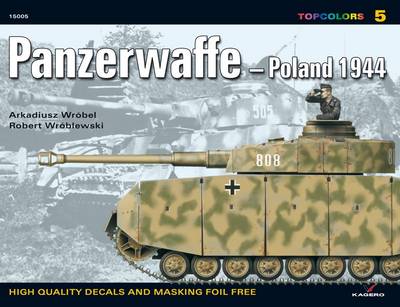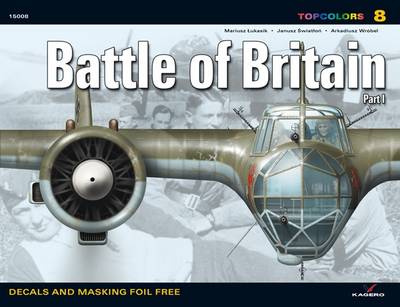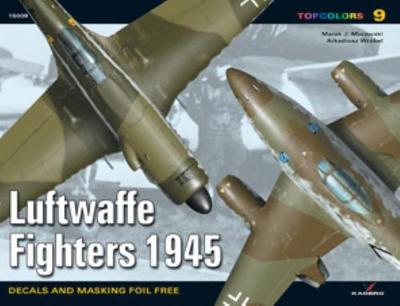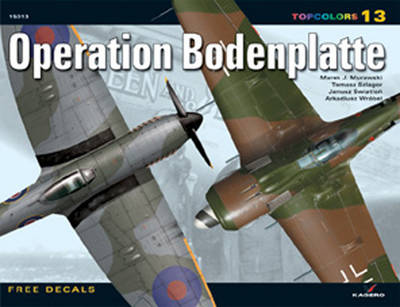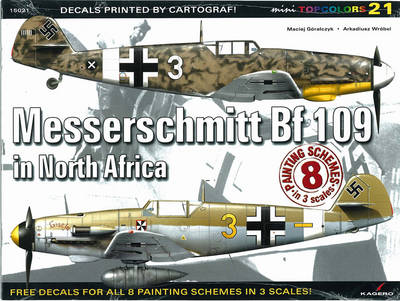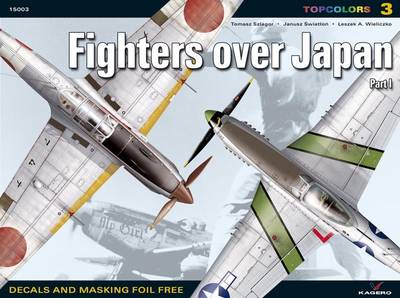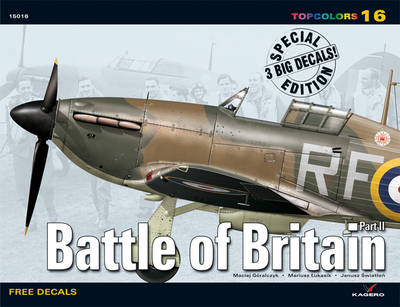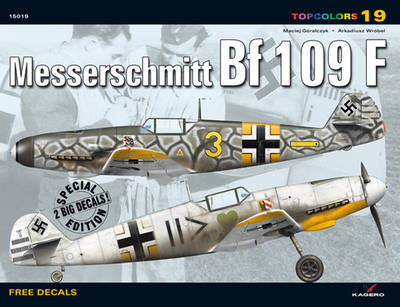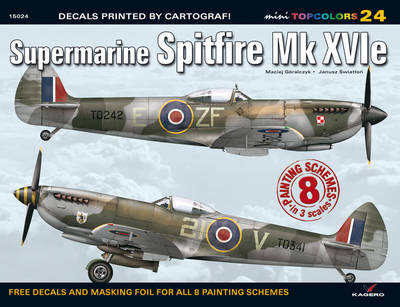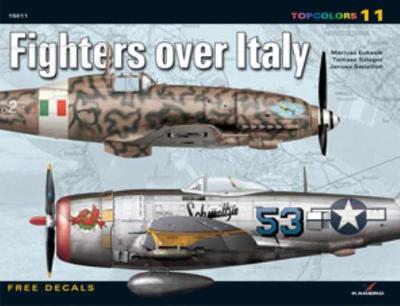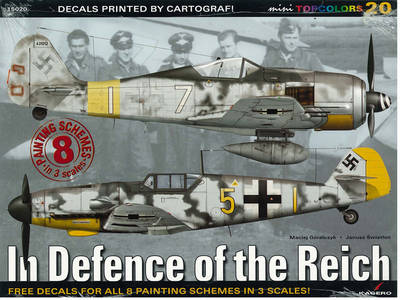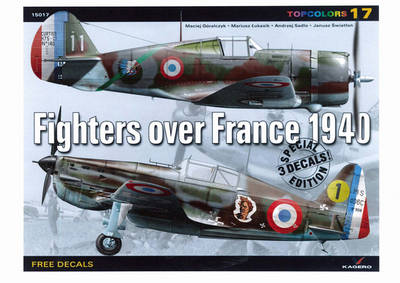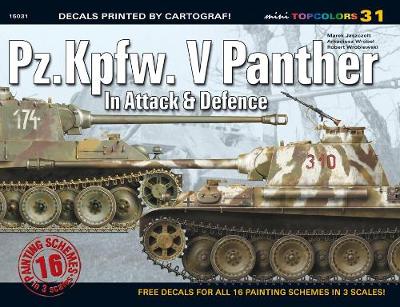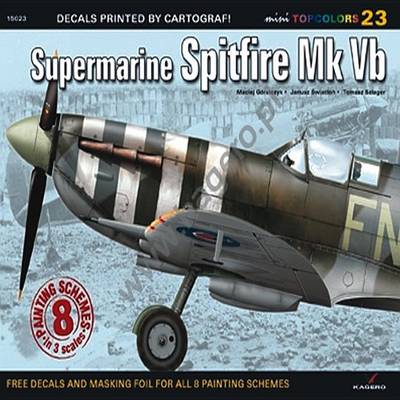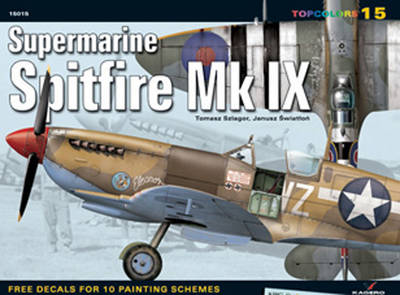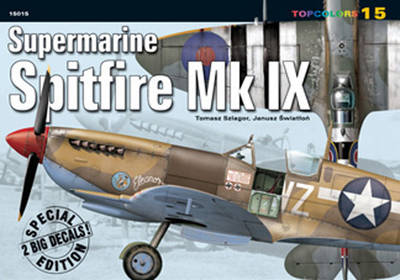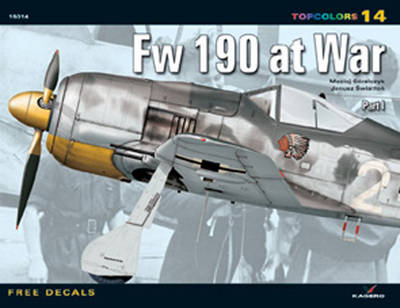Top Colours
19 total works
During World War II the German army also fielded a number of Panzergrenadier divisions consisting of motorised infantry (or armoured infantry for some of the battalions, when sufficient half-tracked armoured carriers were available), with self-propelled artillery and Jagdpanzer, and in some cases a significant panzer component.
This is a guide to the camouflage and markings used by the Panzerwaffe (German tanks and associate equipment) in Poland in 1944, featuring 44 colour profiles and Including free decals.
About the Series
This is a series of highly illustrated books on the key machines of World War II and their combat use. Perfect for modellers and filled with colour artwork profiles, each volume details the camouflage, markings, insignia, modifications and variants of the best of the war. With extra features such as decals, photo-etched brass and masking foil.
Battle of Britain Part I
by Arkadiusz Wrobel, Janusz Swiation, and Mariusz Lukasik
A crucial turning point of WWII, the German airforce’s 1940 campaign against Britain was the first campaign to have been entirely carried out by aircraft. It pitched the German Messerschmitt Bf 109E and the Bf 110C against the British Hurricane Mk 1 and the Spitfire Mk 1. The Bf 109E and the Spitfire were particularly well-matched in speed and agility.
There were four phases to the battle, starting with the conflicts over the Channel from 10 July, through to the attacks on coastal airfields, inland airfields and British towns and cities. These required the usage of a variety of aircraft, such as the German bombers the Heinkel He 111, the Dornier Do 17, and the Junkers Ju 88.
About the Series
This is a series of highly illustrated books on the key machines of World War II and their combat use. Perfect for modellers and filled with colour artwork profiles, each volume details the camouflage, markings, insignia, modifications and variants of the best of the war. With extra features such as decals, photo-etched brass and masking foil.
About the Series
This is a series of highly illustrated books on the key machines of World War II and their combat use. Perfect for modellers and filled with colour artwork profiles, each volume details the camouflage, markings, insignia, modifications and variants of the best of the war. With extra features such as decals, photo-etched brass and masking foil.
Operation Bodenplatte
by Arkadiusz Wrobel, Tomasz Szlagor, and Janusz Swiatlon
The operation was a Pyrrhic success for the Luftwaffe as the losses suffered by the German air arm were irreplaceable. The losses of the Allied Air Forces were replaced within weeks. The operation failed to achieve air superiority, even temporarily, for the Luftwaffe and the German Army continued to be exposed to air attack. Bodenplatte was the final major Luftwaffe offensive during World War II.
About the Series
This is a series of highly illustrated books on the key machines of World War II and their combat use. Perfect for modellers and filled with colour artwork profiles, each volume details the camouflage, markings, insignia, modifications and variants of the best of the war. With extra features such as decals, photo-etched brass and masking foil.
Messerschmitt Bf 109 in North Africa
by Maciej Goralczyk and Arkadiusz Wrobel
The Messerschmitt Bf 109 was a German World War II fighter aircraft designed by Willy Messerschmitt in the early 1930s. It was one of the first true modern fighters of the era. Having gone through its baptism of fire in the Spanish Civil War, the Bf 109 was still in service at the dawn of the jet age at the end of World War II.
Part of a series of highly illustrated colour reference books, the numerous colour profiles and 3 views of the variants of the Bf 109 show the distinctive sandy colouring essential for desert combat to full effect.
This volume also includes a decal sheet with 1:72, 1:48 and 1:32 individual markings.
About Topcolors
This is a series of highly illustrated books on the key machines of World War II and their combat use. Perfect for modellers and filled with colour artwork profiles, each volume details the camouflage, markings, insignia, modifications and variants of the best of the war. With extra features such as decals.
Fighters Over Japan Part 1
by Leszek A. Wieliczko, Tomasz Szlagor, and Janusz Swiatlon
About the Series
This is a series of highly illustrated books on the key machines of World War II and their combat use. Perfect for modellers and filled with colour artwork profiles, each volume details the camouflage, markings, insignia, modifications and variants of the best of the war. With extra features such as decals, photo-etched brass and masking foil.
The book contains colour profiles of the following British and German fighters:
Supermarine Spitfire Mk.I (X4382) coded LO-G of No 602. Sqn RAF
Supermarine Spitfire Mk.I (N3249) coded QJ-P of No 92. Sqn RAF
Supermarine Spitfire Mk.I (X4474) coded QV-I of No 19. Sqn RAF
Hurricane Mk.I (V7607) coded DT-H of No 257. Sqn RAF
Hurricane Mk.I (P3143) coded NN-D of No 310. Sqn RAF (czeski)
Hurricane Mk.I (P3144) coded GZ-B of No 32. Sqn RAF
Hurricane Mk.I (V7504) coded RF-G of No 303. Sqn RAF
Hurricane Mk.I (V6941) coded WX-W of No 302. Sqn RAF
Hurricane Mk.I (P2923) coded VY-R of No 85. Sqn RAF
Bf 109 E-1; W.Nr. 3367, 'Red 14', 5./JG 52
Bf 109 E-3; W.Nr. 1155, 'Black 11', 5./JG 3
Bf 109 E-3; 'Black 1', dowódca 5./JG 51
Bf 109 E-4; W.Nr. 5153, 'Yellow 5', 9./JG 3
Bf 109 E-4; W.Nr. 1641, 'Black 6', 2./JG 51
Bf 109 E-4; W.Nr. 5159, 'White 9', 1./JG 2
Bf 109 E-4; 'Black Chevron', III./JG 53
Bf 110 D-0/B; W.Nr. 3371, coded S9+AH, Erprobungsgruppe 210
Bf 110 C-5; coded 5F+MM from 4.(F)/14*
The Spitfire was designed as a short-range high-performance interceptor aircraft with an elliptical wing, allowing a higher top speed than several contemporary fighters, including the Hawker Hurricane.
Supermarine developed a two-seat variant known as the Mk VIII to be used for training.
About the Series
This is a series of highly illustrated books on the key machines of World War II and their combat use. Perfect for modellers and filled with colour artwork profiles, each volume details the camouflage, markings, insignia, modifications and variants of the best of the war. With extra features such as decals, photo-etched brass and masking foil.
The first Bf 109s saw service in the Spanish Civil War. By September 1939, the Bf 109 became the mainstay fighter of the Luftwaffe by World War II, replacing the biplane fighters, and was instrumental in gaining air superiority for the Wehrmacht during the Blitzkrieg. During the Battle of Britain the type was pressed into new roles as an escort fighter, a role it was not originally designed for, and was widely employed as a fighter-bomber as well as for photo-reconnaissance. Despite mixed results over Britain, with the introduction of the improved Bf 109F into widespread operational service in the spring of 1941, the type proved again to be an effective fighter during the Invasion of Yugoslavia, the Battle of Crete and Operation Barbarossa, the invasion of the USSR and during the Siege of Malta.
About the Series
This is a series of highly illustrated books on the key machines of World War II and their combat use. Perfect for modellers and filled with colour artwork profiles, each volume details the camouflage, markings, insignia, modifications and variants of the best of the war. With extra features such as decals, photo-etched brass and masking foil.
There were 24 marks of Spitfire and many sub-variants. These covered the Spitfire in development from the Merlin to Griffon engines, the high-speed photo-reconnaissance variants and the different wing configurations. The Mk XVIe was produced during the latter half of World War II and was created as an improvement on the Mk IX Spitfire. With the introduction of the Packard Merlin engine, the Mk XVIe was a noteworthy addition to Britain’s fighter aircrafts.
About Topcolors
This is a series of highly illustrated books on the key machines of World War II and their combat use. Perfect for modellers and filled with colour artwork profiles, each volume details the camouflage, markings, insignia, modifications and variants of the best of the war.
Fighters Over Italy
by Mariusz Lukasik, Tomasz Szlagor, and Janusz Swiatlon
With 45 colour profiles, markings, codes, camouflage schemes, and free decals, this is a must for modellers.
About the Series
This is a series of highly illustrated books on the key machines of World War II and their combat use. Perfect for modellers and filled with colour artwork profiles, each volume details the camouflage, markings, insignia, modifications and variants of the best of the war. With extra features such as decals, photo-etched brass and masking foil.
Each profile shows side and plan views in amazing detail, an invaluable aid to any modelling enthusiast.
About Topcolors
This is a series of highly illustrated books on the key machines of World War II and their combat use. Perfect for modellers and filled with colour artwork profiles, each volume details the camouflage, markings, insignia, modifications and variants of the best of the war.
An American model, the P-38 Lightning was a fighter aircraft deployed in WWII, most successfully for the so-called`Pacific Theater of Operations’ and the `China-Burma-India Theater of Operations’. Its distinctive design involved twin booms but only one central nacelle which earned it the nicknames “fork-tailed devil” and “two planes, one pilot” by its enemies.
The versatility of the P-38 Lightning allowed it to perform several functions, such as level bombing, dive bombing and photo reconnaissance missions as well as its tradition role as a long range fighter.
About the Series
This is a series of highly illustrated books on the key machines of World War II and their combat use. Perfect for modellers and filled with colour artwork profiles, each volume details the camouflage, markings, insignia, modifications and variants of the best of the war. With extra features such as decals, photo-etched brass and masking foil.
This book details in full colour all the aircraft involved in the fight over France, containing numerous colour profiles, with full markings and insignia shown. Hurricanes, Fairey Battles, and Blenheims are just some of the aircraft featured. This is a complete illustrated reference for all those interested in the end of The Phoney War and the true start of the bloodiest conflict the world has ever seen.
About the Series
This is a series of highly illustrated books on the key machines of World War II and their combat use. Perfect for modellers and filled with colour artwork profiles, each volume details the camouflage, markings, insignia, modifications and variants of the best of the war. With extra features such as decals, photo-etched brass and masking foil.
Until 1944, it was designated as the Panzerkampfwagen V Panther and had the ordnance inventory designation of Sd.Kfz. 171. On 27 February 1944, Hitler ordered that the Roman numeral V be deleted from the designation.
The Panther tank was a compromise of various requirements. While sharing essentially the same engine as the Tiger I tank, it had better frontal armor (including the benefit of a sloping angle, increasing effective armor depth), better gun penetration, was lighter overall and thus faster, and could handle rough terrain better than the Tigers. The tradeoff was weaker side armor; the Panther proved to be deadly in open country and shooting from long range, but vulnerable to close-quarters combat. Also, the 75 mm gun fired a slightly smaller shell than the Tiger's 88 mm gun, providing less high explosive firepower against infantry.
Kagero present a new volume of the informative MiniTOPCOLORS series which shows you 16 colourful profiles of one of the most popular World War II tanks.
The high quality illustrations are based on historical photographs of the famous German tank. The Pz.Kpfw. V Panther was produced from January 1943 through to April 1945 and proved a ferocious opponent. This highly illustrated new title contains large decals sheet in three popular scales.
Supermarine Spitfire Mk Vb
by Tomasz Szlagor, Janusz Swiatlon, and Maciej Goralczyk
- Spitfire Mk Vb (R6923) coded QJ-S of No. 92 Squadron RAF, flown by F/O Alan Wright, Biggin Hill, April 1941,
- Spitfire Mk Vb (W3579) coded OU-Q of No. 485 Squadron RNZAF, flown by W/C Edgar Norman Ryder, Dunkirk, 31 October 1941,
- Spitfire Mk Vb (AB276) coded RY-K of No. 313 (Czechoslovak) Squadron RAF, flown by F/L Václav Hájek, Hornchurch, April 1942,
- Spitfire Mk Vb (P8742) coded WX-A of No. 302 (Polish) Squadron RAF, Harrowbeer, April 1942,
- Spitfire Mk Vb (BM579) coded FN-B of No. 331 (Norwegian) Squadron RAF, flown by F/L Rolf Arne Berg, Manston, early July 1942,
- Spitfire Mk Vb (EN908) coded GW-Y of No. 340 (French) Squadron RAF (Le groupe de chasse 'Île-de-France'), flown by Capt. François de Labouchère, Hornchurch, August 1942,
- Spitfire Mk Vb (EP829) coded T-N of No. 249 (Gold Coast) Squadron RAF, flown by its CO S/L John Joseph Lynch Jnr., Krendi, late April 1943,
- Spitfire Mk Vb Trop (ER187) coded WZ-C of 309th Fighter Squadron USAAF, flown by its CO Maj. Frank A. Hill, La Senia, May 1943.
About Topcolors
This is a series of highly illustrated books on the key machines of World War II and their combat use. Perfect for modellers and filled with colour artwork profiles, each volume details the camouflage, markings, insignia, modifications and variants of the best of the war. With extra features such as decals and masking foil.
After the Battle of Britain, the Spitfire became the backbone of RAF Fighter Command and saw action in the European Theatre, Pacific Theatre and the South-East Asian theatre. Much loved by its pilots, the Spitfire saw service in several roles, including interceptor, photo-reconnaissance, fighter-bomber, carrier-based fighter, and trainer; it was built in many different variants, with two different types of engine and several wing configurations.
About the Series
This is a series of highly illustrated books on the key machines of World War II and their combat use. Perfect for modellers and filled with colour artwork profiles, each volume details the camouflage, markings, insignia, modifications and variants of the best of the war. With extra features such as decals, photo-etched brass and masking foil.
After the Battle of Britain, the Spitfire became the backbone of RAF Fighter Command and saw action in the European Theatre, Pacific Theatre and the South-East Asian theatre. Much loved by its pilots, the Spitfire saw service in several roles, including interceptor, photo-reconnaissance, fighter-bomber, carrier-based fighter, and trainer; it was built in many different variants, with two different types of engine and several wing configurations.
About the Series
This is a series of highly illustrated books on the key machines of World War II and their combat use. Perfect for modellers and filled with colour artwork profiles, each volume details the camouflage, markings, insignia, modifications and variants of the best of the war. With extra features such as decals, photo-etched brass and masking foil.
When it was first introduced in 1941, it was quickly proven to be superior in all but turn radius to the Royal Air Force's main front-line fighter, the Spitfire Mk. V. The 190 wrested air superiority away from the RAF until the introduction of the vastly improved Spitfire Mk. IX in the autumn 1942. Improvements to the 190 were met by similar improvements in its opponents throughout the middle of the war, allowing the 190 to maintain relative parity with its Allied counterparts until the widespread introduction of the P-51 Mustang in early 1944.
About the Series
This is a series of highly illustrated books on the key machines of World War II and their combat use. Perfect for modellers and filled with colour artwork profiles, each volume details the camouflage, markings, insignia, modifications and variants of the best of the war. With extra features such as decals, photo-etched brass and masking foil.
